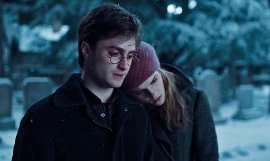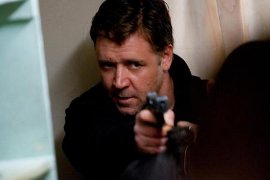 HARRY POTTER & THE DEATHLY HALLOWS: PART I
HARRY POTTER & THE DEATHLY HALLOWS: PART I
About two-thirds of the way through Harry Potter & the Deathly Hallows: Part I, Rupert Grint's Ron Weasley finally has it out with Emma Watson's Hermione Granger and Daniel Radcliffe's Harry. Fed up with the apparent hopelessness of their latest quest, and more than a bit peeved about his eternal status as Harry's second banana, Ron angrily asserts that the three wizards-in-training aren't finding anything and aren't getting anywhere, and eventually storms off in a huff. Never in my life have I felt so connected to Rupert Grint.
In many ways, it's easy to see how arguments could be made for Deathly Hallows I being the most polished and impressive of the seven films thus far in the wildly popular film franchise. Director David Yates, helming his third consecutive Harry Potter adaptation, lends the proceedings an epic grandeur that rarely slips into portentousness, and he's aided greatly by the talents of cinematographer Eduardo Serra, whose nighttime imagery, especially, is evocative and frequently stunning. The film's production design, as you'd expect, is glorious throughout. Every so often, one of author J.K. Rowling's more lyrical inspirations will startle you with its emotional resonance, such as the early, haunting moment that finds an anguished Hermione magically obliterating herself from her parents' memories, her image slowly fading from the Grangers' family photos.
And in their seventh go-round as Rowling's heroic trio, Radcliffe, Watson, and Grint have never been finer. The Harry Potter movies have always offered a haven (and, presumably, a healthy paycheck) for the finest British character actors not named McKellen or Stewart, and Yates' latest finds room for Ralph Fiennes, Helena Bonham Carter, Alan Rickman, Brendan Gleeson, Robbie Coltrane, Julie Walters, Rhys Ifans, and roughly two dozen other recognizable thespians. But with most of them only popping up for one brief scene, the weight of Deathly Hallows I falls squarely on the shoulders of its young leads, and it's a pleasure to report that they carry the load with exceptional nuance, conviction, and skill. For at least an hour of the film's nearly two-and-a-half-hour running length, there's no one on-screen but Harry, Hermione, and Ron, yet the characters' portrayers are so wonderfully invested that you don't even miss the enjoyably eccentric contributions of their elder co-stars.
A good thing, too, because God was this movie tough to sit through. As I've repeated in these pages almost every year over the past 10, I've yet to read a word of Rowling's prose, and I readily concede that the Harry Potter films are simply Not Meant for Me - nor, really, for anyone who hasn't happily devoured the book series. The audience isn't even given passing reminders what roles, say, Timothy Spall's Wormtail or David Thewlis' Remus Lupin played in previous installments; there are times, many times, when the understandable but unfortunate lack of backstory makes Deathly Hallows I feel like a colossal in-joke without a punchline. And as usual, this new work crowds and confuses things further by introducing even more Rowling characters for us to keep track of, some of whom are dispatched, and not at all satisfyingly, just when they're getting kind of interesting. (Was it my imagination, or was Bill Nighy's Minister of Magic - a seemingly important figure, because his closeup opens the film - actually killed off-screen?)
But while there are occasional diversions even for the Rowling virgins among us - none more riveting than the gorgeously animated fairy-tale sequence that gives the movie its title - Deathly Hallows I's oppressive melancholia and slowness systematically drain the fun from the film; in one mid-film "action" scene that finds our heroes disguised as middle-aged Muggles, Yates even exacerbates the pokey-ness by having characters run around in slow-motion. I understand that this concluding chapter of the Harry Potter saga is designed to be more introspective, thoughtful, and sad than its predecessors, but seriously, couldn't the pace have been picked up a little? The scenes in which our youthful trio attempts to find and destroy four precious horcruxes, in particular, are so aimless and sluggish that even the film's rare jokes land with a thud. When, at around the two-hour mark, our heroes finally succeed in demolishing one and Ron makes a crack about there being "only three to go," barely anyone in the audience laughs, perhaps because the thought of six more hours of such narrative dawdling is too much to bear.
Achingly protracted though it is, Deathly Hallows; Part I may, for the devout, be bliss. This more casual Harry Potter viewer, however, just left grateful that the film was as handsomely produced and forcefully performed as it was ... and that, barring flashbacks, the unfailingly obnoxious CGI critter Dobby was finally out of the picture for good. Speaking in third-person, the nauseating little irritant squawks, "Dobby has no master! Dobby is a free elf!" Dobby is a pain in the ass.
 THE NEXT THREE DAYS
THE NEXT THREE DAYS
There are plenty of action thrillers in which you can't wait to get past all the annoying exposition and character development and immerse yourself neck-deep in car chases, shoot-outs, and perilous escape sequences. Writer/director Paul Haggis' The Last Three Days, however, is the exact opposite: an action thriller in which the exposition and character development are so enthralling that you really have no desire to get to the car chases, shoot-outs, and perilous escape sequences. That's not to say that these genre staples, here, aren't well-done; though the film - which finds Russell Crowe's community-college professor planning to bust wife Elizabeth Banks out of a maximum-security prison - is mostly, and occasionally wildly, implausible, events at least move at a slick tempo, and Haggis delivers plenty of exciting, nerve-jangling set pieces throughout. (Banks' attempt to throw herself out of a speeding car is particularly harrowing.) But what draws you into The Last Three Days' world are the lovely, emotionally accurate early scenes between Crowe and Banks - the movie works because of how palpably you feel their marital connection - and the devastating bursts of humanism provided by Olivia Wilde, Brian Dennehy, Jason Beghe, Aisha Hinds, Allan Steele, Lennie James, Daniel Stern, and others who help make this rather traditional Hollywood entertainment impressively, and unusually, specific. Beyond a few silly plot contrivances and the somewhat unwise cameo by Liam Neeson (sporting a dodgy, geographically unidentifiable tough-guy accent), my one major gripe with the film lies in the casting of Crowe. Despite the actor's beautifully textured performance, nothing quite disguises the fact that his mild-mannered everyman seems like a brooding, recognizably Crowe-ian bad-ass from the start, so his gradual evolution to gun-toting white knight has little kick. I generally love seeing Russell Crowe on-screen, but I love him more when his presence isn't making me think he just stole a perfect role away from Paul Giamatti.










